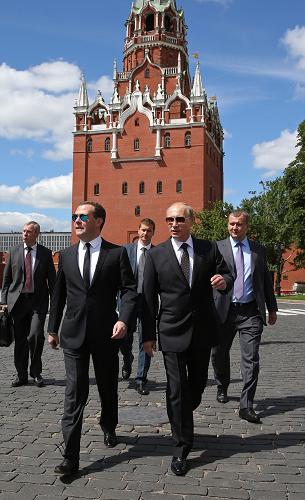US mistakes in Ukraine Crisis and the containment of Russia
- By Zheng Yu
 0 Comment(s)
0 Comment(s) Print
Print E-mail China.org.cn, June 26, 2014
E-mail China.org.cn, June 26, 2014
|
|
|
Russia's President Vladimir Putin (R) and Prime Minister Dmitry Medvedev (L) walk near the Tomb of the Unknown Soldier in Moscow on June 22, 2014. Putin called on Ukraine's leadership and rebels to start genuine dialogue, saying Kiev should halt military operations and guarantee the rights of Russian speakers in the separatist east. [Xinhua photo] |
Russia’s plan to establish a “Eurasian Union” has prompted the United States to pick up its policy of seeking the strategic containment of Russia. In this regard, a news story entitled “Clinton vows to thwart new Soviet Union” appearing on the Financial Times website on 6 December 2011 had caught much attention. Hillary Clinton, then US Secretary of State, told a news conference in Dublin that the US was trying to prevent Russia from recreating a new version of the Soviet Union under the ruse of economic integration. She warned, “There is a move to re-Sovietise the region. … It’s going to be called a customs union, it will be called Eurasian Union and all of that. … We know what the goal is and we are trying to figure out effective ways to slow down or prevent it”. Her tone signaled that the US was rethinking its “reset” in relations with Russia as declared in 2009.
A key motivation of the “reset” policy is the eastward shift of the world’s center of gravity and the recognition that China is the biggest challenge to US global leadership. However, the Obama administration has at the same time been weary and cynical about the Russian government under Putin, which has a number of sticking points with the US. To keep a potential strategic competitor at bay and preserve a uni-polar world order under Pax Americana, Washington must prevent Moscow from building a Eurasian Union that includes Ukraine – and thus thwart any chance of a revived Soviet Union. America’s strategic interests demand that it does this, even at the risk of further straining relations with the Kremlin.
So, the containment of Russia is not driven by impulse. But this is not to deny that the US has made serious mistakes in handling the Ukraine crisis: it thought Russia would be resigned to the removal of Viktor Yanukovich on 22 February, just as it did following Viktor Yushchenko’s lead over Yanukovich, who had won more votes in the first round, in the January 2005 presidential run-off. Washington calculated that removing Yanukovich could kill any chance of Ukraine joining the Eurasian Union in the near term, end the Ukraine crisis and enable itself to focus on the shifting strategic balance in the world. Unexpectedly for the US, Russia responded by taking over Crimea and supporting insubordination by eastern and southern Ukraine against the interim government in Kiev. This set the scene for lingering instability, one from which the US cannot extricate itself in the short term. At the end of the day, Washington finds itself in a strategic dilemma of having to fight on both the eastern and western fronts.
Striking an agreement akin to the Austrian State Treaty of 1955, whereby the US, the Soviet Union, Britain and France supported the neutrality of Austria is what will most likely solve the crisis in Ukraine. Under this scenario, the US, Russia, and the European Union would jointly guarantee the sovereignty and territorial integrity of Ukraine. By accepting neutrality, Ukraine could avoid becoming a pawn in the military and security contest between the East and the West. This is a far more appealing prospect than the federal system that Russia desires for Ukraine, and one that would sow the seeds for the further disintegration of the country.







Go to Forum >>0 Comment(s)